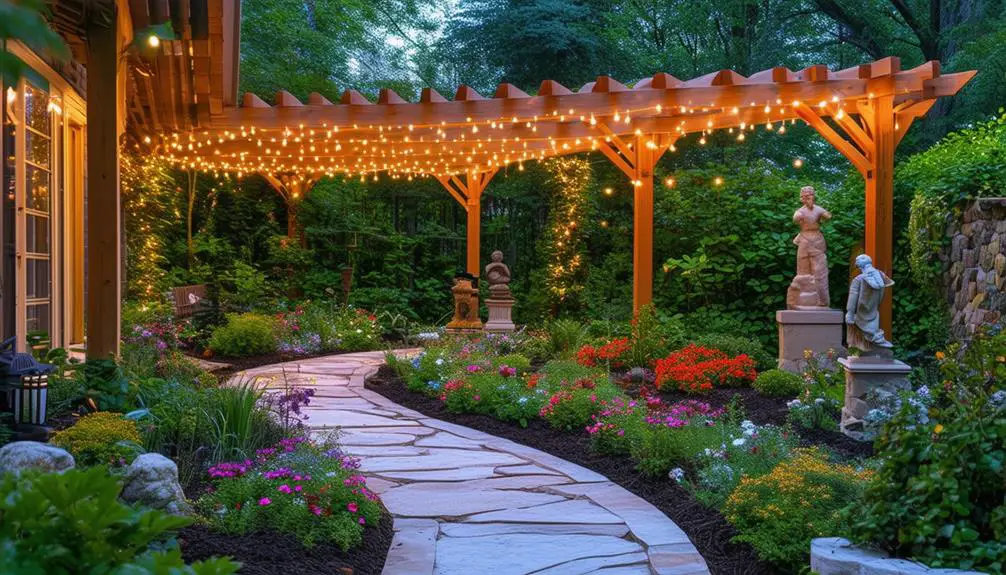As you step into your small outdoor space, you envision a serene oasis where you can unwind and connect with nature.
But where do you start?
You’re not alone in facing the challenges of limited space.
By embracing creative strategies, you can transform your compact yard into a haven that’s both functional and visually appealing.
From maximizing vertical space to selecting the right plants and containers, there are many clever ways to make the most of your small home garden.
Let’s explore these innovative ideas together, and discover how to turn your tiny outdoor area into a tranquil retreat that’s all your own.
Maximizing Vertical Space Potential
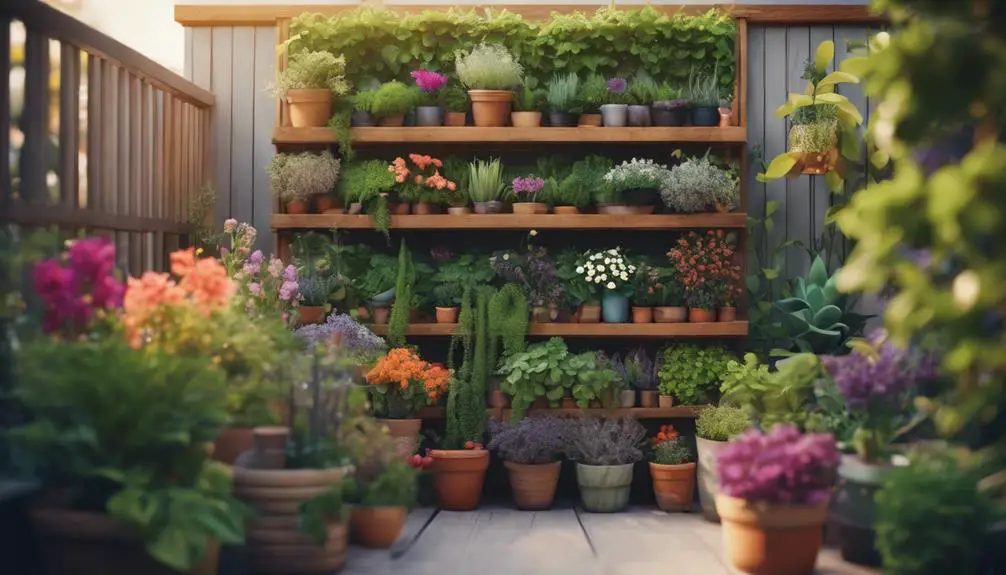
By training vining plants like peas, beans, or cucumbers to climb up trellises or arbors, you can tap into the often-wasted vertical space in your small home garden, effectively multiplying your growing area without sacrificing precious square footage.
This innovative approach allows you to optimize your garden’s layout, creating a visually striking and productive space.
To secure your trellises or arbors, use wall anchors that can support the weight of the plant and its fruit.
These anchors come in various styles, from simple screws to decorative brackets, ensuring a seamless integration with your garden’s aesthetic.
For a more extensive vertical garden, consider installing vertical grids, which provide a sturdy framework for your plants to climb.
These grids can be attached to walls, fences, or even freestanding structures, offering endless possibilities for customization.
Choosing Compact Plants Wisely
Compact plants are bred to grow smaller, produce smaller leaves, or have a more upright habit, making them ideal for tight spaces.
When selecting compact varieties, consider plant profiling – the shape and size of the mature plant. Look for plants with a compact, bushy habit, like dwarf conifers or naturally compact shrubs.
Consider the plant’s spread, too, opting for varieties that won’t outgrow their boundaries. Check the plant tag or research online to find the mature size of the plant and plan accordingly.
You can also opt for plants that can be pruned or trained to maintain a desired shape, like topiaries or espaliers.
Container Gardening Essentials
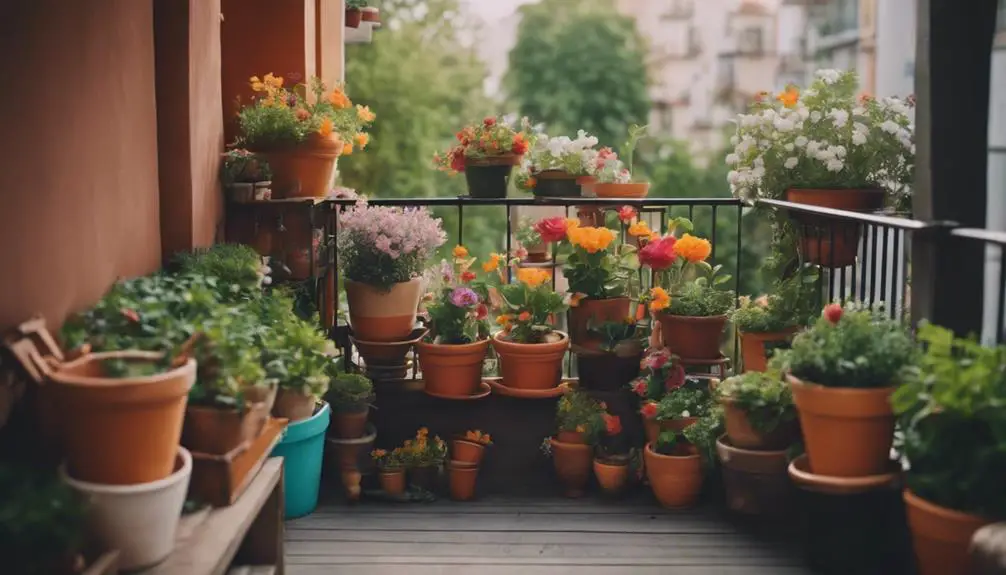
As you set up your container garden, you’ll need to ponder the trifecta of essentials: the right pots, soil, and drainage.
You’ll want to select pots that provide ample room for roots to grow, while also ensuring they fit snugly in their designated space.
Choosing the Right Pots
You’ll need pots that not only complement your small home garden’s aesthetic but also provide the right environment for your plants to thrive, which is why selecting the appropriate container material, size, and drainage system is essential.
When it comes to pot materials, you’ll want to weigh the durability, weight, and aesthetic appeal of options like ceramic, terra cotta, wood, metal, or recycled plastic. Each material has its pros and cons, so think about the specific needs of your plants and the style you’re aiming for. For instance, ceramic pots are great for adding a touch of elegance, while wooden planters bring a natural, rustic feel.
Pot sizes are also pivotal, as they’ll impact the growth and health of your plants. You’ll want to choose pots that provide enough room for the roots to spread out and for the soil to drain properly. Ponder the mature size of your plants and the space available in your garden when selecting pot sizes.
A general rule of thumb is to opt for pots that are at least 5-7 gallons for larger plants and 1-3 gallons for smaller ones. By selecting the right pot materials and sizes, you’ll be well on your way to creating a thriving and beautiful container garden.
Soil and Drainage Matters
When crafting your container garden, selecting the right soil blend is essential, since it directly impacts the health and vigor of your plants, and must be tailored to the specific needs of the species you’re growing.
You’ll want to conduct a soil test to determine the pH level and nutrient content of your chosen mix. This will help you identify any deficiencies or imbalances that need to be addressed.
For instance, if your soil test reveals a lack of organic matter, you can amend it with compost or peat moss to improve its structure and fertility.
Proper drainage is also pivotal to prevent waterlogged soil and root rot.
Consider incorporating drainage solutions like perlite, vermiculite, or expanded shale into your soil blend. These materials help to improve aeration and water penetration, reducing the risk of waterlogging.
Additionally, make sure your containers have adequate drainage holes to allow excess water to escape.
Selecting the Best Plants
With a well-balanced soil blend and proper drainage in place, now it’s time to choose the perfect plants that will thrive in your container garden, taking into account factors like climate, light exposure, and desired bloom times.
You’ll want to select plants that match your garden’s specific conditions. Check the plant hardiness zone to verify the plants you choose can withstand the temperature fluctuations in your area. Think about the amount of sunlight your containers will receive and choose plants that fit those requirements.
When selecting plants, think about the overall aesthetic you want to achieve. Do you want a vibrant, colorful garden or a more subdued, monochromatic theme?
Choose plants that fit your desired garden theme. For a modern look, opt for succulents or cacti. For a whimsical touch, try flowering plants like petunias or begonias.
Don’t forget to think about the mature size of the plants and leave enough space for growth. By choosing the right plants for your container garden, you’ll be on your way to creating a stunning outdoor space that’s both functional and beautiful.
Utilizing Corner Spaces Effectively
As you design your small home garden, you’re likely to encounter tight corners that can either be wasted or wisely utilized.
By incorporating corner planters and baskets, you’ll create a visually appealing display of plants and flowers that thrive in compact spaces.
Next, you’ll want to ponder space-saving trellis designs and hidden storage solutions that optimize every inch of your garden’s corners.
Corner Planters and Baskets
You can create a visually appealing corner garden by placing a compact planter or basket in the often-wasted space, allowing you to grow a variety of plants, from flowering annuals to lush greenery, in a small footprint.
This corner decor adds a touch of elegance to your outdoor space, making it perfect for small homes or apartments.
When selecting a corner planter or basket, consider the style of your garden or patio. For a modern look, opt for sleek, geometric planters made of metal or ceramic. For a more rustic feel, choose wicker or rattan baskets.
Basket styles vary greatly, from traditional to contemporary, so you’re sure to find one that fits your aesthetic.
Look for planters with good drainage and a sturdy base to prevent tipping. You can also add a personal touch by decorating your planter or basket with paint, decoupage, or other embellishments.
Space-Saving Trellis Designs
Beyond the compact planters and baskets, corner spaces can also be optimized with space-saving trellis designs that provide structural support for climbing plants, while adding a decorative element to your small home garden.
You can choose from various trellis styles, such as flat-panel trellises, obelisk trellises, or fan-shaped trellises, to create a visually appealing focal point in your garden.
These trellises can be made from materials like wood, metal, or plastic, and can be adorned with garden ornaments like intricate metalwork, ceramic tiles, or delicate wind chimes.
To maximize corner space, consider installing a wall-mounted trellis or a corner trellis with a curved design.
These space-saving trellis designs won’t only provide support for your climbing plants but also add a touch of elegance to your garden.
Hidden Storage Solutions
Corners, often the most underutilized spaces in small home gardens, can be transformed into clever hiding spots for storage bins, planters, and other gardening essentials with the strategic incorporation of hidden storage solutions.
By installing secret compartments, you can stash away items like gardening tools, seeds, and fertilizers, keeping them out of sight but still within easy reach.
Consider adding hidden shelves or sliding drawers to your corner spaces. These can be cleverly disguised as planters or decorative features, providing ample storage without disrupting the aesthetic of your garden.
You can also repurpose old pallets or crates to create rustic, space-saving storage units that blend seamlessly into your garden’s design.
To maximize corner storage, think vertically. Install a trellis or a living wall with built-in planters and storage compartments. This won’t only provide a hiding spot for your gardening essentials but also add a touch of greenery to your garden.
Small Patio Design Ideas
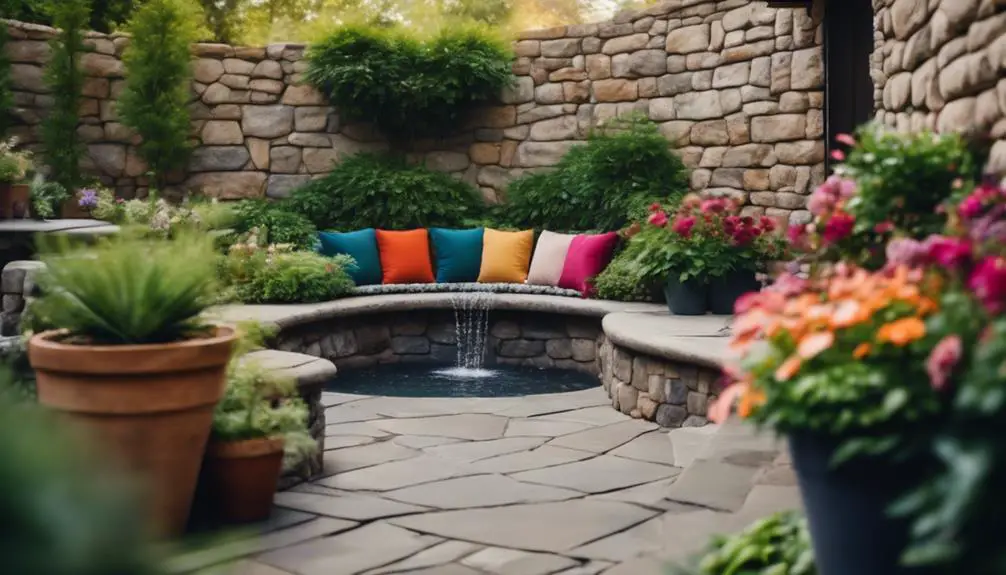
As you step into your compact outdoor space, a well-designed small patio can transform it into a serene retreat, complete with a miniature oasis, inviting seating areas, and thoughtful layouts that maximize every inch.
To create a functional and stylish patio, consider multi-functional patio furniture that serves more than one purpose, such as a storage bench or a table with built-in planters. Opt for space-saving seating arrangements like a circular conversation pit or a built-in banquette.
Don’t be afraid to think vertically – install a trellis or a pergola to provide shade and create a sense of enclosure.
When selecting patio furniture, look for sleek, low-profile designs that won’t overwhelm the space. Consider using materials like recycled plastic, metal, or sustainably sourced wood that are both eco-friendly and durable.
Finally, don’t forget to incorporate ambient lighting to create a warm and inviting atmosphere in the evenings.
DIY Trellis and Arbors
As you plan your DIY trellis and arbor project, you’ll want to ponder the overall garden structure design, thinking about how the framework will support the vines and flowers you’ll be training to grow.
You’ll also need to decide on the type of materials and construction methods that will create the decorative yard features you envision.
Garden Structure Designs
You can create a stunning focal point in your small home garden by designing and building a DIY trellis or arbor that provides support for climbing plants while adding visual interest to the space.
By incorporating garden gates and decorative fencing, you can create a sense of separation and definition within your garden, highlighting the trellis or arbor as a central feature.
Consider using natural materials like wood or bamboo for a rustic, organic look, or opt for metal or PVC for a more modern, sleek aesthetic.
When designing your trellis or arbor, think about the scale and proportion of the structure in relation to the surrounding plants and garden features.
You can also add decorative details like intricate latticework or ornate finials to give your DIY project a unique, personalized touch.
Vines and Flowers Support
Building a DIY trellis or arbor provides an opportunity to train vines and flowers to grow upward, creating a lush, layered look that adds depth and visual interest to your small home garden.
By doing so, you’ll encourage air circulation, reduce disease transmission, and make vine pruning a breeze.
You can use a variety of materials, such as wooden dowels, metal rods, or even repurposed items like old gates or fencing, to create a unique and functional support system.
When selecting the perfect trellis or arbor, consider the mature size of your vines and flowers, as well as their growth habits.
For instance, climbing roses or clematis require sturdy structures, while delicate flowers like sweet peas or morning glories can thrive on lighter flower stakes.
Don’t forget to add decorative elements, such as lattice patterns or intricate carvings, to enhance the visual appeal of your DIY project.
With a little creativity and some basic construction skills, you can create a stunning vines and flowers support system that will elevate your small home garden to the next level.
Decorative Yard Features
Beyond providing functional support, your DIY trellis or arbor can also serve as a decorative yard feature that adds visual appeal and personality to your small home garden.
As a focal point, it can draw the eye towards a specific area, creating a sense of depth and visual interest.
You can customize your trellis or arbor with intricate details, such as latticework, curves, or geometric patterns, to create a unique statement piece.
Consider incorporating yard ornaments, like small statues or birdhouses, to add an extra layer of whimsy.
Alternatively, you can use your DIY structure as a backdrop for outdoor sculptures, creating a striking visual contrast between the natural surroundings and the man-made art piece.
By choosing materials that complement your garden’s color scheme and style, your trellis or arbor can seamlessly blend in while still making a bold statement.
With a little creativity, your DIY project can become a stunning decorative yard feature that elevates your small home garden’s aesthetic appeal.
Making the Most of Shady Areas
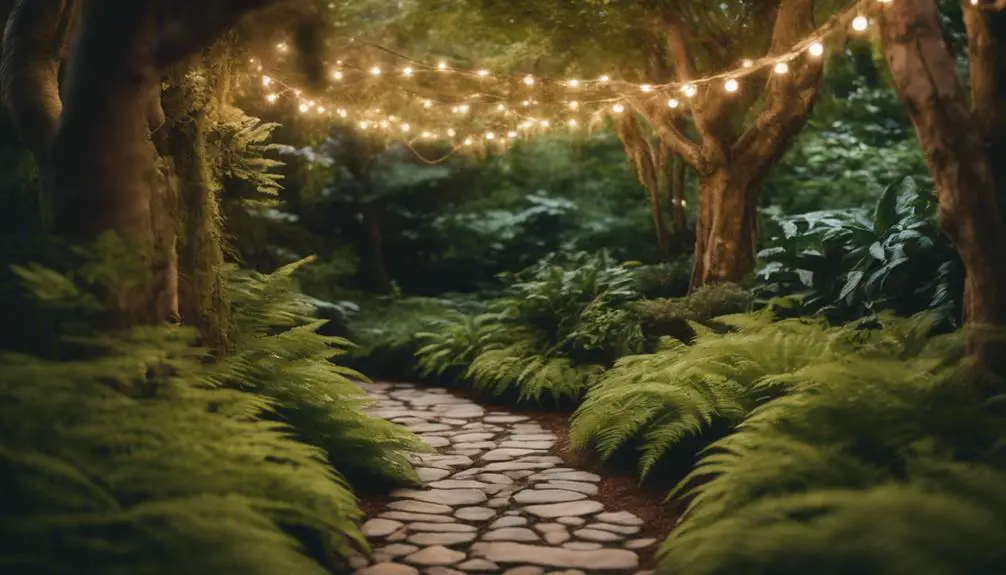
Shade, often considered a limitation in gardening, can actually become a unique opportunity to cultivate a diverse range of plants that thrive in low-light conditions.
You can create Shady Nooks, intimate spaces that invite relaxation and contemplation, by carefully selecting plants that flourish in shade. Shade Lovers like hostas, astilbe, and ferns will add texture, color, and depth to these areas.
To make the most of your shady areas, consider the specific conditions of each spot. Is it partial shade or full shade? Are the soil conditions moist or dry?
Choose plants that are tailored to these conditions, and group them thoughtfully to create visual interest. Consider the mature size of each plant, and leave enough space for air circulation and growth.
Don’t be afraid to get creative with your Shady Nooks. Add a statement piece, like a moss-covered statue or a unique planter, to draw the eye to the area.
Incorporate natural elements, like wood or stone, to create a sense of harmony with the surrounding environment. By embracing the unique challenges of shady areas, you can create a tranquil oasis that’s all your own.
Creative Uses for Railings
As you explore ways to maximize your small home garden’s potential, consider repurposing railings into functional and visually appealing features that add depth and interest to your outdoor space.
One creative approach is to transform railings into railing planters, where you can attach small pots or planters to hold herbs, succulents, or flowers. This not only adds a touch of greenery but also creates a sense of layers and texture.
Another idea is to use decorative rails to create a trellis or arbor, providing support for climbing plants like ivy, clematis, or roses.
You can also repurpose old railings as a unique divider or screen, adding visual interest to your garden’s layout.
For a more whimsical touch, hang wind chimes, lanterns, or other decorative elements from the railings to create a sense of movement and sound.
Space-Saving Garden Paths
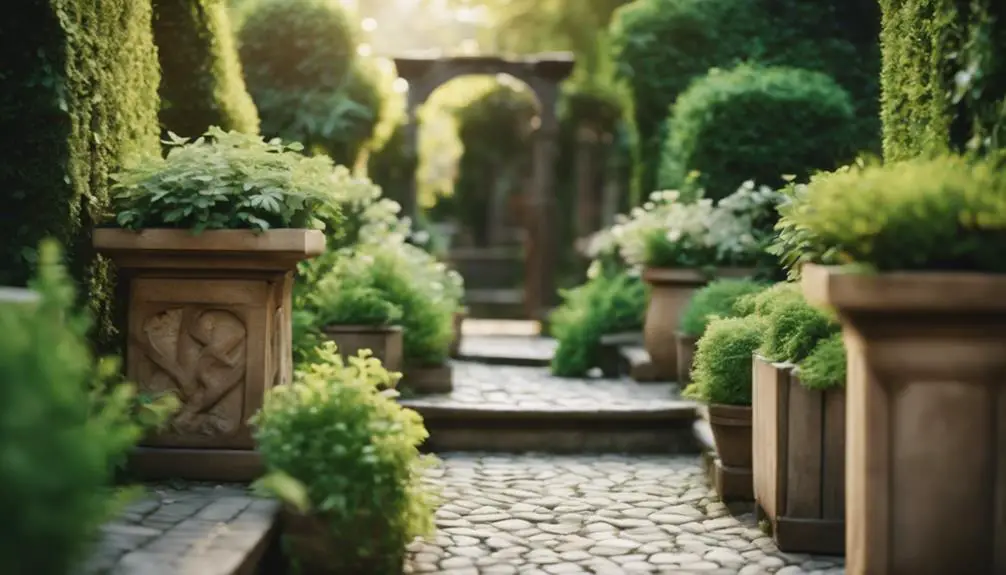
To make the most of your small home garden, consider narrowing your pathways to create a sense of flow and direction, allowing you to allocate more space to planting beds and features.
By doing so, you’ll create a more intimate and inviting atmosphere. When selecting materials for your pathways, opt for gravel alternatives like decomposed granite or compacted stone dust, which provide better traction and are easier to maintain.
These alternatives also allow for better drainage and can help reduce weed growth.
To add visual interest, incorporate stepping stones or pavers into your pathway design.
These can be arranged in a meandering pattern to create a sense of movement or in a more formal, linear design to create a sense of structure.
Consider using materials like bluestone or fieldstone for a natural, rustic look or porcelain pavers for a more modern aesthetic.
Mini Water Feature Ideas
Create a soothing oasis in your small home garden by incorporating mini water features, such as tiny fountains or bubblers, that provide a visually striking focal point and a calming soundtrack of gently flowing water.
These mini water features can be cleverly integrated into your garden’s design, adding a touch of serenity and visual interest to even the smallest of spaces.
Consider installing a compact water wall, which can be mounted vertically to save space, creating a mesmerizing display of flowing water that will captivate your senses.
Alternatively, you can opt for a small fountain that produces a gentle, soothing sound, perfect for creating a peaceful ambiance.
To enhance the visual appeal of your mini water feature, incorporate surrounding plants with varying textures and colors, creating a cohesive and inviting atmosphere.
Balcony Garden Inspiration

Transforming your balcony into a lush oasis is within reach, even with limited square footage, by incorporating clever design elements and selecting plants that thrive in containers.
Imagine sipping your morning coffee amidst a vibrant display of flowers, or unwinding after a long day in a cozy retreat that’s all your own.
To create an urban oasis on your balcony, start by selecting a statement piece, like a bold planter or a show-stopping trellis, to anchor the space.
Then, choose a mix of plants with varying textures, colors, and heights to add depth and visual interest.
Consider trailing plants like ivy or clematis to spill over the balcony railing, softening the edges and creating a sense of flow.
Add some ambient lighting, like string lights or lanterns, to enhance the ambiance and create a warm glow.
With a little creativity and attention to detail, you can turn your balcony into a serene escape that’s the perfect antidote to the hustle and bustle of city living.
Edible Gardening in Small Spaces
With every square inch of space at a premium, you’ll want to maximize your edible garden’s yield by opting for compact, high-producing varieties of vegetables, fruits, and herbs that can thrive in shallow containers or vertically-stacked planters.
Consider cherry tomatoes, dwarf citrus, and leafy greens like kale and spinach, which can be harvested continuously. These space-saving options will allow you to grow a diverse range of produce, enhancing your food security and contributing to urban agriculture.
To make the most of your small space, utilize vertical gardening methods like trellising, arbors, or living walls. These won’t only add visual interest but also increase your harvest.
Don’t forget to incorporate companion planting, where different species are paired to promote healthy growth and pest control. For example, plant marigolds with tomatoes to deter nematodes.
Lighting for Ambiance and Function
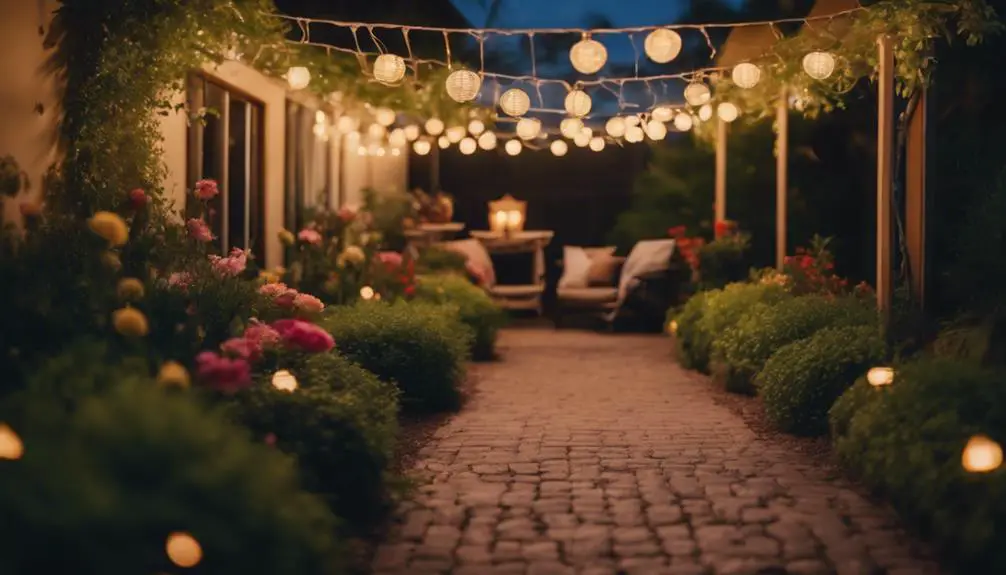
Sixteen to twenty hours of sunlight per day is ideal for most plants, but in small home gardens, strategic lighting can bridge the gap between natural and supplemental light, fostering healthy growth and ambiance.
You can create a mesmerizing atmosphere by layering different light sources, from soft moonlight fixtures to vibrant string lights.
For a warm, cozy glow, consider installing solar lanterns along pathways or around seating areas. These energy-efficient lights harness the sun’s power during the day and radiate a gentle, golden light at night.
To highlight specific features, like a statement piece of art or a show-stopping plant, use directional spotlights or uplights.
These will draw attention to the focal point while creating dramatic shadows. You can also experiment with color-changing lights to create a dynamic, immersive experience.
As you design your lighting scheme, remember to balance function and ambiance. Verify that walkways are well-lit for safety, while also creating pools of light that invite relaxation and contemplation.
Frequently Asked Questions
How Often Should I Water My Small Home Garden?
“You’ll want to establish a water schedule based on soil moisture levels, checking daily by inserting your finger into the top 2-3 inches of soil; water when it feels dry to the touch, usually every 2-3 days in warm weather.”
Can I Grow Vegetables in a Small Home Garden?
You can definitely grow veggies in a compact space! Select varieties bred for container growth, like patio tomatoes or baby carrots. Place containers in a spot receiving at least 6 hours of direct sunlight, and don’t forget to rotate them for even growth.
Do I Need to Fertilize My Small Home Garden Regularly?
You’ll want to fertilize regularly, but first, test your soil to determine its pH levels and nutrient deficiencies, then choose the right fertilizer type, such as organic, synthetic, or compost, to optimize your harvest’s growth and quality.
How Do I Keep Pests Out of My Small Home Garden?
To keep pests out, you’ll want to strategically plant pest deterrent plants like basil and mint around your garden’s perimeter, while also creating natural barriers, such as copper tape or fine-mesh screens, to block unwanted critters.
Can I Have a Small Home Garden Without a Yard?
You can cultivate a thriving garden without a yard by utilizing indoor containers with built-in irrigation systems and LED grow lights, or opt for balcony gardening with trellises and hanging baskets that maximize vertical space.
Conclusion
As you step into your revamped small home garden, the lush greenery, soft lighting, and gentle water sounds envelop you in serenity.
You’ve successfully transformed a compact space into a tranquil oasis, perfect for relaxation and rejuvenation.
Every element, from the climbing vines to the petite planters, works in harmony to create a visually stunning retreat.
Your clever use of vertical space, thoughtful plant selection, and attention to detail have resulted in a peaceful haven that’s all your own.


